Begonia: secrets of care at home
Begonia is a flower of amazing beauty. This plant can become a worthy decoration of both the garden and the windowsill. The big advantage is that begonia is not only unpretentious and takes root perfectly indoors, but is also represented by hundreds of species, so everyone can choose the most attractive flower for themselves.
Begonia in Detail / Types
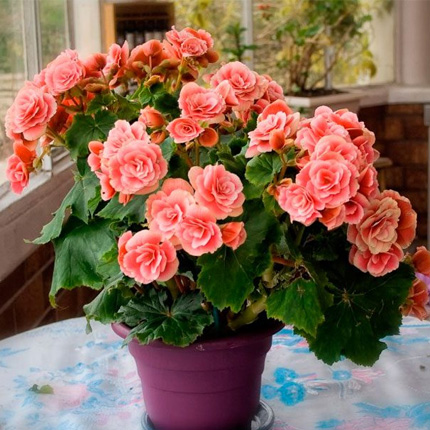
The plant belongs to the Begonia family, which includes more than 1,000 species and 2,000 hybrids. It is native to the tropical and subtropical zones of Southeast Asia (India, Tibet, Sri Lanka), as well as South and Southwest Africa (including Madagascar). The species is most often found in mountainous areas at an altitude of about 3,500-4,000 m (~11,480-13,120 ft.) above sea level, but it can also grow in humid forests. The inter-rock areas and rhizomes of old trees are also favorite places of this plant. Begonia has long been known and studied, managing to take root in Europe and America, but it is in Africa that the largest global percentage of this plant grows.
The size of begonias varies from 5-10 cm (~0.2-0.3 ft.) to 2-3 m (~6.6-9.8 ft.). There are also many classifications of the species, but plant growers have come up with several categories that are most often found at home. These are decorative-flowering indoor; decorative-deciduous indoor; and decorative-flowering potted begonias. Among these, there are evergreen and perennial species, as well as creeping and tall annual flowers, but all of them are united by the bright foliage and lush flowering. Begonia carolineifolia is the most common indoor begonia; it can be bought at a gardening store or ordered online. The prompt delivery of flowers in Kyiv will not take up much time.
Let us focus in more detail on the features of this and other species.
Begonia Carolineifolia
This plant was brought to us from distant Mexico. The begonia has a rather thick creeping stem and large leaves with carved edges and clearly visible veins. The leaf plates are large and can be 30 cm (~1 ft.) long or more. This variety blooms with fluffy pod-shaped inflorescences; the flowering period starts at the end of winter.
King Begonia (Begonia Rex)
The birthplace of Begonia rex is the eastern regions of India. The flower received its name for a reason: it has a high decorative value. Moreover, it was this species that became the basis for breeding the largest number of hybrids. The plant is really striking in its beauty; its thickened rhizome and large leaves up to 25-30 cm (~0.8-1 ft.) long and up to 15-20 cm (~0.5-0.7 ft.) wide have a shape resembling a heart with carved or wavy edging. They can be either symmetrical or asymmetrical. The leaf color is most diverse: bronze-brown, terry-crimson, or bright red-violet. Sometimes there may be varieties with red or silver splashes. The hybrid subspecies with black crimson-speckled leaves is also very popular. It is worth noting that such a begonia blooms with completely inconspicuous small pale-pink flowers.
The most beautiful varieties of Begonia rex:
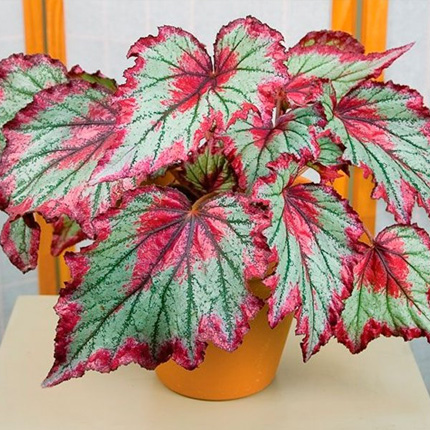
- Cartagena. This species is distinguished by rich green leaves of a semicircular shape that resemble a snail shell. The center of each leaf is dark brown, but becomes purple-lilac over time. The leaf is strewn with silvery spots with a pinkish tint over the entire area.
- Silver Greenheart. This variety has silver heart-shaped leaves with dark emerald edging and white speckles.
- Chocolate Cream. This plant has twisted leaves of a silvery tone with a green core. Some species may have a powdery tint.
- Evening Glow. This begonia has relatively large leaves with a bright pink middle and similar edging. The veins are brown.
- Hallelujah is a variety of begonia with large, shell-shaped pale-purple leaves with a silver sheen. The middle and edges of the leaf plate are wine-colored, and the remaining leaf space is filled with a rich green stripe dotted with silver specks.
Begonia ‘Tiger’ (Bowerae)
This species is also often found under the name ‘maple leaf begonia’. Its homeland is Central America. A mature plant doesn’t grow above 30 cm (~1 ft.); moreover, the flower has a creeping stem. The leaves are of a light green shade with black or dark brown spots along the edges. There is a small fluff on the underside of a leaf. The plant blooms with pale-pink small flowers in fluffy inflorescences. Overall, this begonia is not often found in the natural environment, but thanks to the successful work of breeders, the variety has become the basis for numerous hybrids with a bewitching appearance.
The most beautiful varieties of this begonia:
- ‘Tiger’ is the brightest representative of the species with a creeping stem. Under favorable conditions, it can grow up to 10 m (~32.8 ft.). Its brown-veined bronze leaves have a pattern and are soft and silky to the touch. The shoots grow with a reddish tint.
- Cleopatra. In this variety, the leaves can change their color depending on the intensity of lighting. The outer side of the leaf is covered with small light-green hairs, and the underside is red or burgundy.
Begonia Corallina
This beautiful variety grows as a semi-shrub. Its homeland is the tropics of South America. At home, it can grow up to 1 m (~3.3 ft.), so it often requires pruning. The long straight shoots are somewhat reminiscent of bamboo stalks. The leaf plates have an elongated shape with the total length of up to 20 cm (~0.7 ft.) and serrated edges; they are oblong, ovate, up to 20 cm (~0.7 ft.) long and up to 7 cm (~0.2 ft.) wide. The upper side of the leaves is rich-green with silver speckles, while the underside is light-green. The species blooms with inflorescences; the petals are of a soft coral color.
The most beautiful varieties of Begonia corallina:
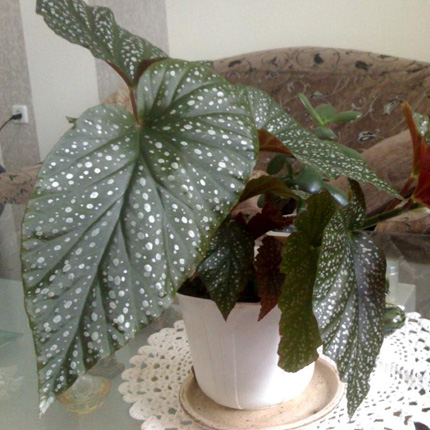
- Alfalfa is a variety with large carved-edge leaves that are covered with silvery patches on the upper side. The other side is red.
- President Carnot is a begonia with broad green serrated leaves covered with white spots. The length of the leaf plate can reach 30 cm (~1 ft.), the width, 15 cm (~0.5 ft.).
Ever-Blooming Begonia (Begonia Semperflorens)
The ever-blooming begonia is a semi-shrub herbaceous plant 50-60 cm (~1.6-2 ft.) high with straight shoots, which turn into hanging ones as the species matures. The leaves of this variety are rounded, slightly fluffy along the edges, and have a short length of up to 5 cm (~0.2 ft.) with a range of shades from light-green to dark-green. The species with a red tint occur rarely. This variety received its name because the flowering of begonia, although not lasting long, is very quickly replaced by young inflorescences of a whitish or pink hue. If Begonia semperflorens grows and develops under favorable conditions with regular and sufficient watering, top dressing, and the necessary degree of lighting, the plant will delight you with its flowering in the cold season.
The most beautiful varieties of ever-blooming begonias:
- Gustav Knaake. This fluffy shrub up to 30 cm (~1 ft.) high has bright-green leaves with a red border and bright red flowers up to 3 cm (~ 0.1 ft.) in diameter. It takes root well indoors.
- Carmen is a variety of begonia with brown leaf plates and dense pale-pink inflorescences.
- Ambra is a begonia up to 15 cm (~ 0.5 ft.) high with burgundy leaves and pink flowers.
- Bicola is a small shrub with bright-green leaves and white-flowered buds. Sometimes a pink stripe may be present along the edges of the petals.
- Orania is another undersized shrub begonia. The leaves are green with a red border, and the flowers are orange-red.
Begonia x elatior
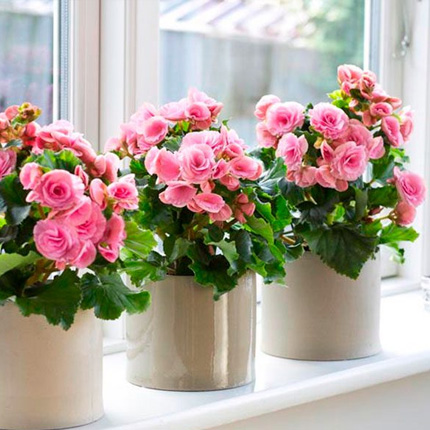
This variety is recognized as one of the most beautiful and most abundantly flowering ones. Many prefer this particular species when choosing an indoor begonia. It reaches no more than 35-40 cm (~1.1-1.3 ft.) in height. The plant has a thick stem and heart-shaped leaves up to 7 cm (~0.2 ft.) long with a serrated edge. The outer side of the leaves is glossy; the underside is matte and has a lighter shade. Coral or pink flowers grow in inflorescences on long peduncles.
The most beautiful varieties of Begonia x elatior:
- Schwabenland: reaches a height of 1 m (~3.2 ft.) and blooms profusely with small rich red inflorescences.
- Renaissance: a variety with velvet leaves that grows up to 50 cm (~1.7 ft.) and has flowers with red corrugated petals.
- Louise is a popular variety with powdery milky flowers.
- Piccora is a begonia shrub of low height with velvety flowers of a bright-pink tone.
- Rose is a beautiful variety with rich pink buds.
Ampel Begonia (Begonia x Tuberhybrida Pendula)
Thanks to its falling branches, the ampel begonia has long been a frequent guest on our balconies and terraces. The spreading cascades with fluffy, densely arranged flowers are a real decoration of any interior. It is most convenient to grow the plant in wicker baskets and pots. The species includes several varieties that have the most diverse appearance, size, and structure.
The most beautiful varieties of the ampel begonia:
- Gale is a fluffy, voluminous shrub with long falling shoots up to 30 cm (~1 ft.) long with sharp carved leaves of bright-green color and double light-pink flowers up to 2-3 cm (~0.07-0.1 ft.) in diameter.
- Christie is another fluffy shrub with hanging shoots up to 50 cm (~1.6 ft.) long and white velvety flowers up to 5 cm (~0.2 ft.) in diameter.
- Rocsana is a medium-sized shrub with hanging shoots up to 50 cm (~1.6 ft.) long with double orange flowers up to 5 cm (~0.2 ft.) in section.
- Kati is a compact shrub with shoots up to 30 cm (~1 ft.) long with slightly velvety yellow flowers up to 4 cm (~0.1 ft.) across.
The Most Popular Hybrid Varieties of Decorative-Flowering Begonias
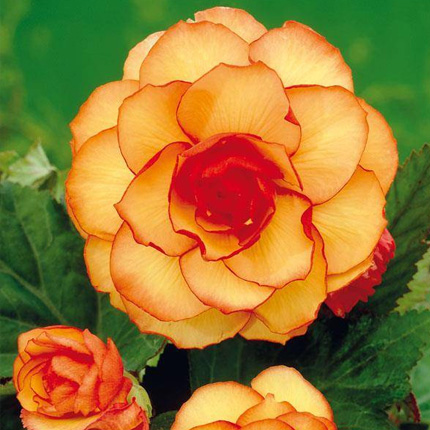
Harlequin is a lush shrub with spreading branches up to 30 cm (~1 ft.) long. Its leaves are bright-green, and the double-petaled flowers are yellow with red edging. The diameter of each flower is impressive: up to 12 cm (~0.4 ft.).
Gold Dress is a fluffy shrub begonia, reaching a height of 30 cm (~ 1 ft.). The leaves are characterized by a pale-green tint. The flowers resemble yellow rosebuds and are quite large: up to 20 cm (~0.7 ft.) in cross section.
Dark Red is another sprawling begonia shrub that reaches a height of no more than 15 cm (~0.5 ft.). Its leaves are dark-green in color, and the velvety buds, reminiscent of peonies, are rich-red. The flower’s diameter is approximately 10 cm (~0.3 ft.); the petals are quite wide.
Camellia Flora is a compact shrub, up to 20-25 cm (~0.7-0.8 ft.) high. Its leaves are bright-green. The flowers are similar to the tea camellia (10-12 cm / ~0.3-0.4 ft. in diameter). The color varies from pink to whitish.
Crispa Marginata is a very small shrub up to 13-15 cm (~0.4-0.5 ft.) high. Its light-green leaves have pronounced purple veins. It blooms with large white flowers that have a contrasting red border. The petals of Crispa Marginata resemble carnation petals in appearance; they are also corrugated.
Amy Jean Bard is another low-growing begonia shrub with medium-sized leaves. It blooms in inflorescences consisting of five small orange flowers.
Diana Wynyard: this variety of begonia can grow no more than 20 cm (~0.7 ft.) in length. Its leaves are light-green and quite large. The flowers are similar in appearance to those of Ami Jean Bard, but are white in color.
Marmorata is a not very fluffy shrub up to 20-25 cm (~0.7-0.8 ft.) high. The large (about 12 cm / ~0.4 ft. in diameter) velvety flowers have a bright red color with white small stripes along the entire surface of the petals.
Feuerflamme is a compact begonia shrub up to 25 cm (~0.8 ft.) high. Its leaves are of a classic green color, against which the pink streaks stand out clearly. The small flowers with velvety petals come in an orange tone with a pinkish tint.
Begonia Care at Home

We have previously described how to grow bonsai, but everything is much simpler in the case of begonia. Keep in mind, though, that the indoor begonia needs to be observed and maintained. The spot where you put it initially should become its permanent “place of residence”. What’s more, begonia doesn’t tolerate crowding. If you already have a lot of potted plants on your windowsill, it’s best not to cram begonias in there. Prepare thoroughly for planting or buying this flower. It also loves fresh air, so airing the room should be regular. However, drafts and sudden temperature changes should not be allowed; otherwise it can lead to the gradual death of the plant, the withering of inflorescences and foliage.
It has already been mentioned that the homeland of begonia is the tropics and subtropics, which means regions with high humidity. Based on this, it is easy to guess that begonia loves moisture. Still, remember not to spray its foliage from a spray bottle. This will cause the appearance of reddish spots on the leaf plates. In order for the plant to receive the desired moisture, it is necessary to build a special tray for it with moistened expanded clay. This is especially important in the cold season, when the indoor air is too dry due to the heating. Make sure that the expanded clay doesn’t dry out.
Lighting and Temperature
The begonia pot should be placed on a well-lit windowsill; however, direct sunlight should be avoided. It is worth noting that decorative-flowering indoor and potted begonias especially love getting a lot of light. Place the plants on windowsills that face east or west. The optimum temperature for begonias is 18-20°C (64.4-68°F). However, the plant will also be able to survive the summer heat.
Soil and Pot

Before you start planting begonia, you need to choose the most suitable container for the flower. The best solution would be to opt for a medium-sized ceramic pot. Indoor begonia doesn’t grow much, and the diameter of its pot should be about 4-5 cm (~0.1-0.2 ft.) larger than the root system. Pots that are too large can cause root rot due to waterlogging. Moreover, the begonia’s flowering will be belated in this case. The soil for planting can be purchased at any gardening store, but you can always prepare the potting mix yourself. If you chose the second option, you will need the leafy humus, river sand, high-moor peat, and sod. All these components should be taken in a ratio of 2:1:1:1. The required level of soil acidity is neutral.
Planting
When you already have a suitable pot for begonia, take it and fill it one-third with drainage material. Put a layer of charcoal 2-3 cm (~0.07-0.1 ft.) thick on top of the drainage so that the rot doesn’t develop. Now you can plant begonia in the pot without removing the soil from its roots, while filling the empty spaces with a pre-prepared substrate. Don’t forget to water your flower immediately after that. The best period for planting is the end of March, when the daylight hours necessary for the normal growth and development of the plant increase. If tubers are present on the begonia’s roots, such a flower must be germinated before planting. To do this, put the plant on the soil mixture without deepening the tubers into the ground, and place it in a sufficiently lit place with moist air and the temperature maintained at 16-18°C (60.8-64.4°F).
Watering
Indoor begonia requires careful adherence to the watering schedule. Although this species loves moisture, it doesn’t need frequent watering. Most importantly, you need to ensure that the air humidity is at a fairly high level; otherwise the tips of the leaves will begin to curl and dry out. During the hot season, begonia needs to be watered more abundantly, but the schedule should be such as to prevent moisture stagnation. It is better to use water at room temperature, which has managed to settle for at least a day. It’s not difficult to understand that it is time to water the flower: when the top layer of the substrate dries to a depth of 2 cm (~0.07 ft.), you can proceed. In late October to early November, as well as in winter, the plant must be watered less often and more moderately. Don’t water the tuberous begonias at all when it’s cold.
Top Dressing
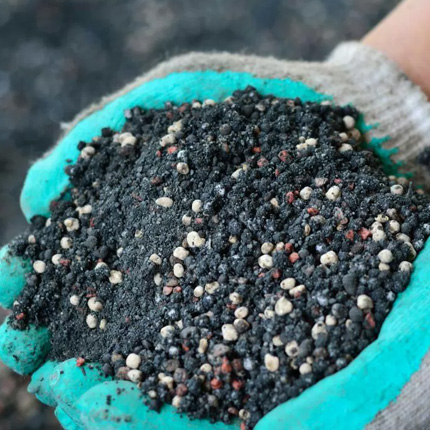
Your begonia needs a fertilizer to grow and develop normally. It is necessary to start feeding decorative-flowering plants after the buds have formed. Top dressing is carried out once every two weeks. A water-soluble complex fertilizer for any flowering indoor plants will be suitable. When the formation of the empty lower thickened part of the pestle begins, it will be necessary to switch to the potassium-phosphorus types of top dressing. The nitrogenous fertilizers are used only with decorative-leafy begonias, since they slow down or completely stop the flowering of decorative-flowering varieties.
Transplanting
Periodic transplanting is required for the full development of any plant, and begonia is no exception. It is necessary to transplant a flower with the onset of spring, that is, before it goes into a period of active growth. As soon as you notice that the begonia’s rhizomes begin to “peck” out of the drainage holes, you can start transplanting. To do this, carefully remove the plant from the pot along with a clod of soil. Next, clear the ground carefully. Prepare a weakly concentrated solution of potassium permanganate and dip the rhizomes into it. After that, rinse the roots in a container of settled water. Be sure to carefully inspect the root system for rot or damage and remove the excess.
Select a new large pot for the begonia, let the roots dry out, and you can start with the transfer. Be sure to put the flower in its original place. It must be watered more often than usual at first after the transplantation. As a rule, there are no particular issues with transplanting begonias, especially in the case of young plants. But with mature specimens, there may be some difficulties associated with the numerous leaf plates. However, there are no unsolvable problems. If your begonia is already 3 years old or more, the plant can be divided into a few parts (or perhaps more).
Pruning
If begonia grows in your garden or in a flower bed, its above-ground shoots die off on their own with the arrival of the first frosts in the late autumn. And if you have an indoor begonia, you will need to cut it yourself. All dried and dead parts of the plant should be removed regularly throughout the year. These actions will not only help maintain the attractiveness of your flower, but will also be an excellent prevention against various diseases, and will stimulate more abundant flowering. A useful tip: carefully cut off the ends of the first stems immediately after planting or transplanting, as this will allow the begonia to bloom luxuriantly.
Begonia in Winter

The ever-flowering begonias practically don’t fall into a dormant period, while the decorative-flowering tuberous varieties do this every winter. The begonia care in winter depends entirely on the specific species. Most often, the pot with the plant simply needs to be moved to a humid place with low temperatures (however, not lower than 15°C / 59°F). To provide the flower with the necessary level of humidity, you can put a humidifier nearby or simply hang the towels soaked in water on radiators.
The tuberous begonias begin to prepare for a dormant period in November. The leaves of the flowers gradually dry and fall off. This gives a signal that you can reduce the watering. In a while, the entire flower will dry out, which means that it is time to transfer it to a prepared spot. Sometimes it happens that even in winter the begonia is not planning to enter the dormant period. However, this is not a cause for celebrating. In this case, the flower must be forcibly “put to sleep” (i.e., by reducing watering and cutting off the entire above-ground part). Otherwise it will not bloom next summer.
Indoor Begonia Propagation Methods
The propagation of indoor begonia is carried out in two ways: by planting seeds or using vegetative organs (cuttings, leaves, roots).
Propagation by Seeds
Growing begonias from seeds is not particularly difficult. This should be done at the end of winter – the beginning of spring, and seeds can be purchased at any specialized gardening store. Pick the required container, fill it with soil mixture, and evenly distribute the seeds on its surface without deepening them. Now you can put the pot in a warm place with good lighting and cover it with a transparent film or plastic lid. The seedlings need to be watered indirectly, that is, with a spray gun or through a pallet. As soon as the first stems sprout, the film can be removed. Transplanting seedlings from a smaller container to a larger one is carried out only after the appearance of the first true leaves. It is customary to plant young begonias in separate pots during the eighth week of life. If you provide the plant with good lighting, the begonia will delight you with its flowering in the first year of life.
Propagation by Dividing the Tuber
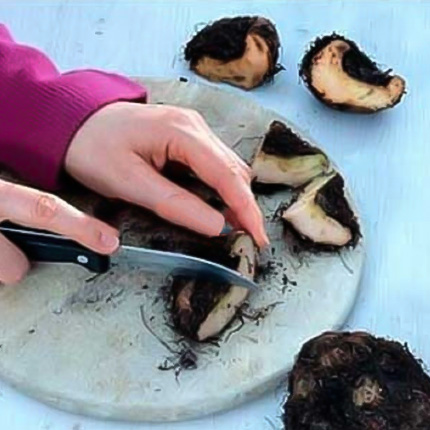
The deciduous varieties of begonia can be propagated by dividing the rhizome. This must be done in the spring; carefully remove the flower from the ground and divide the tuber into several parts with a sharp tool so that each part, in addition to the root, has at least one shoot or one bud. Wait for the cut sections to dry, and then treat them with charcoal powder. Now the parts can be planted in separate pots.
Propagation by Cuttings
Cuttings are one of the easiest ways to propagate begonias. Separate them from a mature shrub with three to four leaves and treat the cuts with fine charcoal. Now you can start with the planting. Prepare the earth mass from sheet soil, peat, and river sand in a ratio of 1:1:1, and plant a cutting there. Place the seedling in a warm and bright place (but without direct sunlight). It should be watered moderately and only after the top layer of the substrate 2 cm (~0.07 ft.) thick becomes completely dry. However, you can do without the soil mixture at all for propagating begonias this way. If you put the cutting in a container of water, it will take root in about a month.
Propagation by Leaf
Begonias are spreading shrubs with a lot of leaves, so if you cut off a couple to plant a new one, nothing bad will happen. In addition, both one full leaf and part of it are suitable for propagation. In the first case, you will need to make several cuts along the central veins on the leaf’s underside. Now the leaf can be placed with the notched side on a layer of wet river sand (you must first heat treat the sand). It is very important that the leaf doesn’t move from its place. Water the seedling only through the pallet. After two months, you will notice how the roots begin to hatch from the incisions, and then the stems. When the seedlings get a little stronger, they can be planted in separate pots in a mixture of soil, peat, and sand in equal proportions.
Possible Issues When Growing Begonia
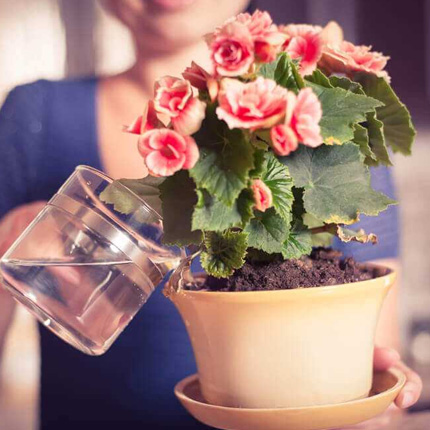
Begonia by its nature is an undemanding to special care and quite resistant species. However, like any other living organism, the plant can face a number of issues.
Diseases and Pests
Of all known insect pests, begonia is most commonly affected by aphids, red spider mites, and roundworms. Ticks and aphids feed on the juices of the plant, which is why the flower loses its decorative effect and rapidly slows down in growth and development. To eradicate aphids, it is necessary to use moderately toxic pesticides. Processing should be carried out in several stages with breaks of one to two weeks. As for the mites, they will disappear after the application of insectoacaricides. In case of roundworm infection, the begonia will have to be disposed of. These parasites are very persistent and practically indestructible. The signs of damage by nematodes are the appearance of sagging on the roots and loss of leaf color.
Among the viral and bacterial diseases that begonia can become infected with, the most common are gray and black root rot, fungus, and powdery mildew. You can cure a flower by treating it with systemic fungicides or Bordeaux mixture. Diseases such as bacterial wilt, cucumber mosaic virus, and tomato bacterial black spot, unfortunately, cannot be cured, and the affected begonia must be destroyed.
Drying
If you notice that the leaves of your begonia have begun to dry slowly, there may be several reasons for this. Either the room is too hot and dry, or watering is insufficient. To solve this problem, water the plant and put it in a cool place. You can also put the pot on a pallet with moist expanded clay.
Yellowing
Are there rings or blotches of yellow on the surface of begonia’s leaves? This is a clear sign of infection with bacterial spotting of tomatoes or cucumber mosaic. As mentioned above, treating such diseases is futile. But if the leaf plates turn yellow and go down, the reason may be that the begonia is freezing or the soil contains too much moisture. In this case, you need to wait until the soil in the pot dries out properly, and then move the plant to a warm place.
Healing Properties of Begonia
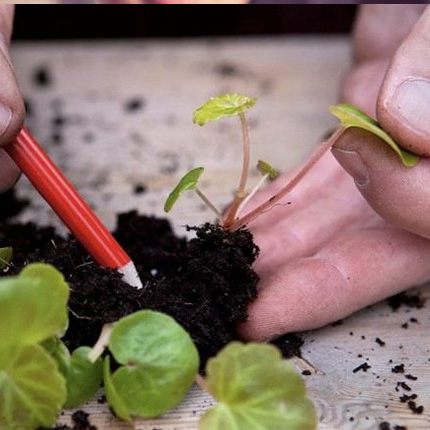
Begonia is one of the most common flowering indoor plants, which has earned its popularity not only due to its high decorative value, but also due to its special healing properties. It is believed that begonia is able to strengthen the human energy field, empower, give determination, and encourage new ideas. That is why it is recommended to put the flower in creative people’s offices. Begonia is considered a businessman’s plant for a reason, as it helps conclude successful transactions, develop flair and intuition. Begonia has also long been known for its ability to absorb poisonous gases. If you have recently completed repairs, bring a pot with this plant to your home. What’s more, it is believed that the indoor begonia is able to clear the bronchi, which is really important for smokers’ apartments.
Magic and Astrology
Begonia represents the fire sign of Aries. Aries are energetic people by nature; if you are a representative of this sign according to the horoscope – or any other sign of the fire element, begonia will get along well with you and grow with mutual sympathy, figuratively speaking. Leo and Sagittarius need begonia in order to balance their unbridled ardor. For Capricorns, Gemini, and Libra, begonia will help gain additional energy and love for life, perhaps even contributing to the search for a soul mate. Pisces, Scorpios, and Cancers, however, may not get along with this plant. If begonia doesn’t receive proper care, it will most likely wither; but if the representatives of these signs surround the flower with love, it will fully thank them with harmony and positive energy.
Energy and Symbolism
According to the language of flowers, begonia means a certain danger, warning, caution. However, in the 18th-19th centuries, a begonia presented as a gift meant an offer to become a true friend.
If you dreamed of begonia buds that adorned your hair or clothes, this means that others don’t understand and maybe even condemn your style and love for non-standard things.
Few houseplants have nicknames, but begonia is one of them. The flower is jokingly called “Napoleon’s ear”. Begonia got this name after the victory in the Patriotic War of 1812, when the similarity of the lower red part of the leaf with the frostbitten ears of French soldiers was noticed.
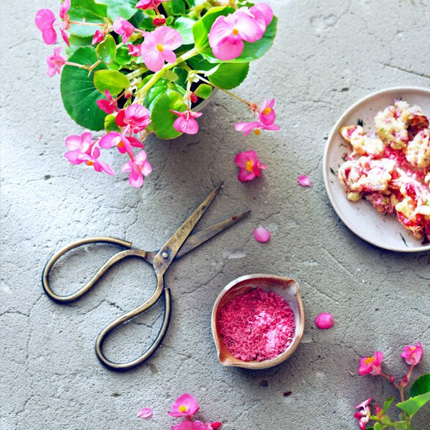
Begonia will create a good mood for all household members. If your close ones often get discouraged, you won’t find a better flower. Begonia rex has the ability to convert negative energy into positive. It will help even if quarrels become commonplace, although, in fact, there is no special reason for them. Begonia supports people with low energy; the flower drives away melancholy and doesn’t allow depression to arise. For those who need to make an important choice in life, the indoor begonia will help decide quickly and find the most optimal way out of the situation by looking at things soberly.
Begonia will be useful to writers, editors, journalists, teachers, and everyone whose occupation is related to texts and oratory. The plant will give you the strength to overcome the inner barrier, speak confidently in public, and find the right and accurate words accompanied with speed. This means that suitable phrases will come to you at the speed of lightning. You will be able to emerge victorious from disputes, and will begin to enjoy communicating with different people.
Begonia Recipes in Folk Medicine
The healing properties of begonia are clinically confirmed. The plant acts as an antiseptic, helps with allergies, heals skin cuts, and relieves spasms. The medicinal mixtures and preparations with begonia stimulate blood circulation and are used to treat wounds, inflammations, and burns. Even in antiquity, the plant was often used as a pain reliever and dehydration aid. Begonia extracts are part of a whole list of healing ointments and liquids for rubbing overstressed muscles and sore joints.
If you spray a begonia infusion indoors, a large number of harmful bacteria and microorganisms will be removed from the air. It has long been confirmed that begonia reduces the amount of staphylococcus in the air by as much as 80%. In addition, begonia is a phytoncide that helps strengthen the immune system and supports the body in resisting viruses and external stimuli that can trigger stress. Experiments were even carried out, confirming that in offices where there are pots with begonias, the working capacity goes up, and the general emotional background is favorable.
Recipe for Inflammation, Burns, and Wounds
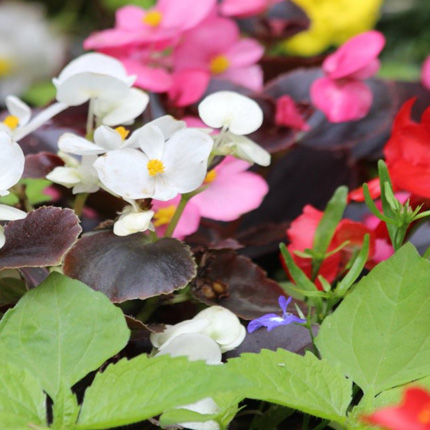
Tear off a few begonia leaves, dry them in the sun, and grind them with a meat grinder or just a pusher. Keep in mind that the meat grinder will be quite difficult to clean afterwards, so the second option is preferable. Squeeze the resulting mixture well and strain through cheesecloth to get the juice. Add purified water to the juice in a 1:1 ratio. The mixture can be used in the form of lotions, preheated in a steam bath. Store the solution on a shelf in the refrigerator, using a container with a tightly screwed lid.
Recipe for Stomach Ulcers and Pneumonia
The tincture for stomach ulcers and pneumonia is prepared in exactly the same way as described above. However, 40% alcohol must be added to the resulting juice in a ratio of 1:1 as the next step. Close the container holding the mixture with a lid, put it on a shelf in a closed cabinet, and leave it there for two weeks, after which strain it. You need to use the tincture by mixing 15 drops with a tablespoon of water, three times a day, 30 minutes before eating. The course of treatment lasts 1 month.
Recipe for Sprains and Bruises
Take a begonia leaf, wash it under running water, and apply it to the affected spot using the backside. Bandage with gauze and leave overnight. In the morning, you will notice that the swelling and puffiness have subsided a little. Begonia acts as a filter, passing the negative waves through itself and returning the positive ones.
Contraindications and Recommendations for Use
When preparing any healing recipes, it is very important to follow the correct dosage and act under the supervision of a medical professional. Keep in mind that among the thousands of species of begonias, the toxic ones are also found. If you use a tincture of poisonous begonia or a tincture prepared in the wrong proportion, you can get off with a slight poisoning, but most often the consequences will be more noticeable. If the poisonous juice has got on the mucous membrane of the nose or the eye, the affected area will most likely turn red and become covered with irritation. Even a simple contact with the skin will cause a burning sensation and itching. In addition, factors such as personal intolerance and allergic reactions, pregnancy and lactation, and the age under 10 years must be taken into account. The doctors also strongly do not recommend self-medication for colds and flu, during periods of epidemics, and to anyone with chronic diseases.
